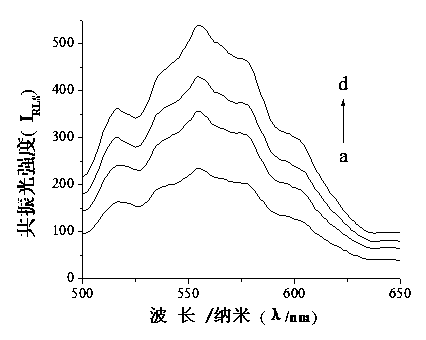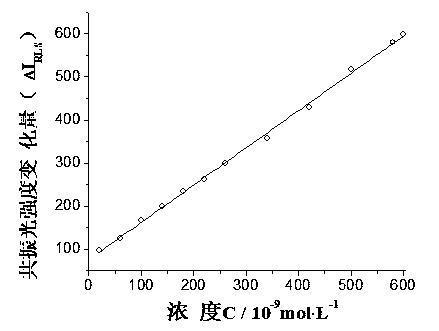Method for rapidly detecting protein in food by using indigo dye
A technology of indigo dye and detection method, which is used in material excitation analysis, fluorescence/phosphorescence, etc., to achieve accurate, convenient and rapid detection, and to improve sensitivity and selectivity.
- Summary
- Abstract
- Description
- Claims
- Application Information
AI Technical Summary
Problems solved by technology
Method used
Image
Examples
Embodiment Construction
[0014] 1. Detection method:
[0015] Add 1.00 ml of 1.0×10 to each of twelve 10 ml colorimetric tubes -4 mol / L indigo solution, then add 20, 60, 100, 140, 180, 220, 260, 340, 420, 500, 580, 600 microliters of 1.0×10 -3 mol / liter of bovine serum albumin solution, and then use pH=4.5, concentration of 0.05 mol / liter of acetic acid-sodium acetate buffer solution to set the volume to the scale, and react for 3 minutes to carry out resonance light intensity detection with a fluorescence photometer, so that The excitation wavelength is the same as the emission wavelength, and the excitation and emission slit widths are both 5 nm.
[0016] 2. Drawing of standard working curve:
[0017] Add 1.00 ml of 1.0×10 to each of twelve 10 ml colorimetric tubes -4 mol / L indigo solution, then add 20, 60, 100, 140, 180, 220, 260, 340, 420, 500, 580, 600 microliters of 1.0×10 -3 mol / liter bovine serum albumin solution, and then use pH=4.5 and acetic acid-sodium acetate buffer solution with a co...
PUM
 Login to View More
Login to View More Abstract
Description
Claims
Application Information
 Login to View More
Login to View More - R&D
- Intellectual Property
- Life Sciences
- Materials
- Tech Scout
- Unparalleled Data Quality
- Higher Quality Content
- 60% Fewer Hallucinations
Browse by: Latest US Patents, China's latest patents, Technical Efficacy Thesaurus, Application Domain, Technology Topic, Popular Technical Reports.
© 2025 PatSnap. All rights reserved.Legal|Privacy policy|Modern Slavery Act Transparency Statement|Sitemap|About US| Contact US: help@patsnap.com



